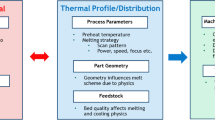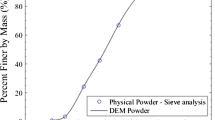Abstract
The aim of this work is to understand the granular behavior of metal powder during the spreading phase of the LBM process in order to study the effect of powder properties and process parameters on the quality of the layer deposited before laser fusion. This is a numerical work performed with simulations based on the discrete element method where each powder grain is simulated. The numerical model takes into account different interactions such as repulsion, dissipation, friction and adhesion that occur when there is contact between two bodies. The powder grains are assumed to be perfectly spherical. The surface roughness of the plate and spreader is taken into account in the simulations as it has a significant impact on the powder bed spreading. The effect of material parameters such as friction and adhesion is studied. The influence of the spreading speed is also studied. The results show that different friction values give the same results on the final properties of the powder bed while adhesion plays a significant role. Finally, lower spreading speed result in a better powder bed.












Similar content being viewed by others
References
Zielinski J, Vervoort S, Mindt HW, Megahed M (2017) Influence of powder bed characteristics on material quality in additive manufacturing. BHM Berg- und Hüttenmännische Monatshefte 162:192–198
Haeri S (2017) Optimisation of blade type spreaders for powder bed preparation in additive manufacturing using dem simulations. Powder Technol 321:94–104
Fouda YM, Bayly AE (2019) A dem study of powder spreading in additive layer manufacturing. Granul Matter 22
Chen H, Chen Y, Liu Y, Wei Q, Shi Y, Yan W (2020) Packing quality of powder layer during counter-rolling-type powder spreading process in additive manufacturing. Int J Mach Tools Manuf 153:103553. https://doi.org/10.1016/j.ijmachtools.2020.103553
Chen H, Wei Q, Wen S, Li Z, Shi Y (2017) Flow behavior of powder particles in layering process of selective laser melting : numerical modeling and experimental verification based on discrete element method. Int J Mach Tools Manuf 123:146–159
Chen H, Wei Q, Zhang Y, Chen F, Shi Y, Yan W (2019) Powder-spreading mechanisms in powder-bed-based additive manufacturing: experiments and computational modeling. Acta Mater 179:158–171
Meier C, Weissbach R, Weinberg J, Wall WA, Hart AJ (2019) Critical influences of particle size and adhesion on the powder layer uniformity in metal additive manufacturing. J Mater Process Technol 266:484–501
Meier C, Weissbach R, Weinberg J, Wall WA, Hart AJ (2019) Modeling and characterization of cohesion in fine metal powders with a focus on additive manufacturing process simulations. Powder Technol 343:855–866
Parteli EJR, Pöschel T (2016) Particle-base simulation of powder application in additive manufacturing. Powder Technol 288:96–102
Haeri S, Wang Y, Ghita O, Sun J (2016) Discrete element simulation and experimental study of powder spreading process in additive manufacturing. Powder Technol 306:45–54
Hoeges S, Zwiren A, Schade C (2017) Additive manufacturing using water atomized steel powders. Met Powder Rep 72:111–117
Nan W, Pasha M, Bonakdar T, Lopez A, Zafar U, Nadimi S, Ghadiri M (2018) Jamming during particle spreading in additive manufacturing. Powder Technol 338:253–262
Cundall PA, Strack ODL (1979) A discrete numerical model for granular assemblies. Géotechnique 29:47–65
André D, Charles JL, Iordanoff I, Néauport J (2014) The granoo workbench, a new tool for developing discrete element simulations and its application to tribological problems. Adva Eng Softw 74:40–48
Hertz H (1882) Ueber die berührung fester elastischer körper. J für die reine und angew Math 92:156–171
Chen H, Xiao YG, Liu Y, Shi Y (2017) Effect of young’s modulus on dem results regarding transverse mixing of particles within a rotating drum. Powder Technol 318:507–517
Johnson KL, Kendall K, Roberts AD (1971) Surface energy and the contact of elastic solids. Proc R Soc 324:301–313
Derjaguin BV, Muller VM, Toporov YP (1975) Effect of contact deformations on the adhesion of particles. J Colloid Interface Sci 53(2):314–326
Fouda, Yahia & Bayly, Andrew. (2019). A DEM study of powder spreading in additive layer manufacturing. Granular Matter. 22
Gladkyy A, Schwarze R (2014) Comparison of different capillary bridge models for application in the discrete element method. Granul Matter 16:911–920
Tan JH, Wong WLE, Dalgarno KW (2017) An overview of powder granulometry on feedstock and part performance in the selective laser melting process. Addit Manuf 18:228–255
Moreau JJ, Panagiotopoulos PD (1988) Non-smooth mechanics and applications. Springer, Berlin
André D (2012) Modélisation par éléments discrets des phases d’ébauchage et de doucissage de la silice, Ph.D. thesis, Université de Bordeaux
Coutsias A, Romero L The quaternions with an application to rigid body dynamics. Technical Report, University of New Mexico, Albuquerque
Nguyen QB, Nai MLS, Zhu Z, Sun CN, Wei J, Zhou W (2017) Characteristics of inconel powders for powder-bed additive manufacturing. Engineering 3:695–700
Poiron P, Sommier N, Faugère AM, Evesque P (2004) Dynamics of size segregation and mixing of granular materials in a 3d-blender by nmr imaging investigation. Powder Technol 141:55–69
Acknowledgements
This work is a part of Additive Factory Hub (AFH) platform. Simulations have been computed with GranOO workbench : www.granoo.org.
Author information
Authors and Affiliations
Corresponding author
Additional information
Publisher's Note
Springer Nature remains neutral with regard to jurisdictional claims in published maps and institutional affiliations.
Rights and permissions
About this article
Cite this article
Marchais, K., Girardot, J., Metton, C. et al. A 3D DEM simulation to study the influence of material and process parameters on spreading of metallic powder in additive manufacturing. Comp. Part. Mech. 8, 943–953 (2021). https://doi.org/10.1007/s40571-020-00380-z
Received:
Revised:
Accepted:
Published:
Issue Date:
DOI: https://doi.org/10.1007/s40571-020-00380-z




